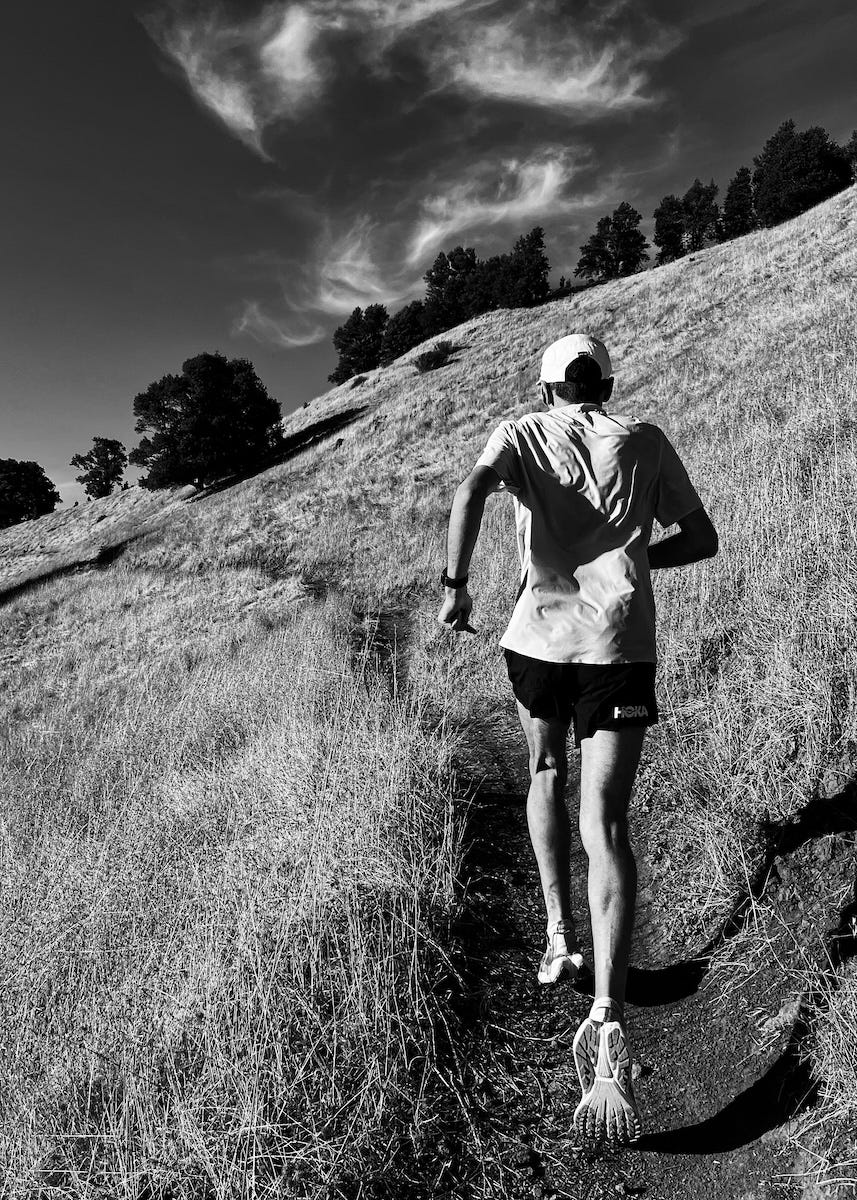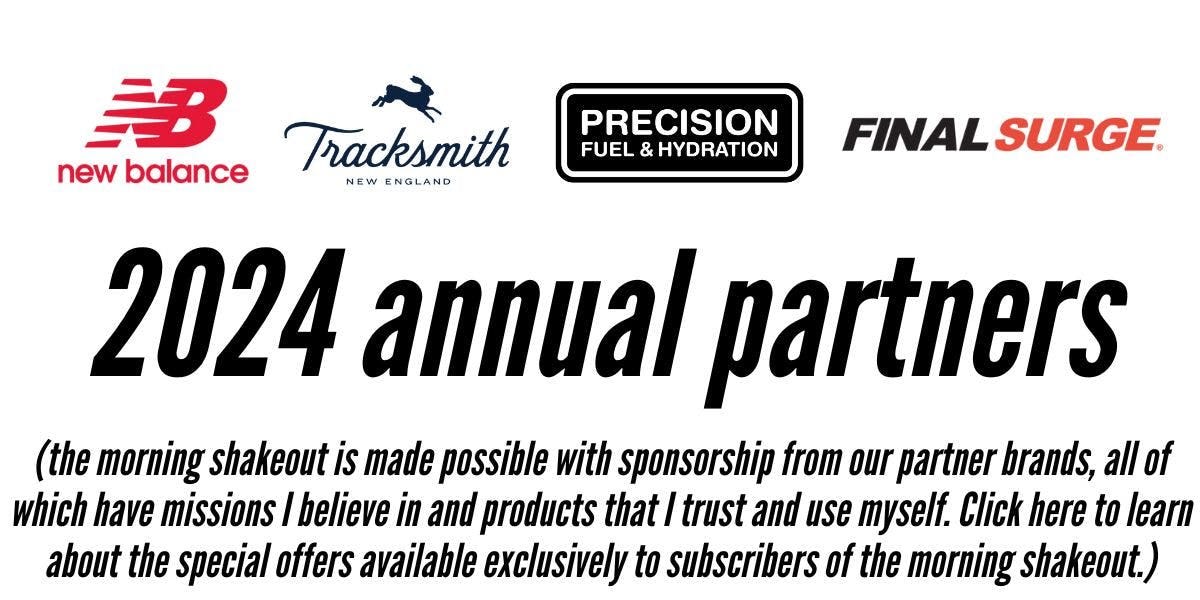the morning shakeout | issue 470
Stick season, what it's all about, knowing when to stop, and a lot more.

Good morning! Back home in New England, where I’m from, the time between late October and early December is often called stick season. (Noah Kahan, a Vermont native, even named his last album after it.) During this post-fall/pre-winter purgatory it gets dark really early, the trees start to go bare, and the weather can get pretty nasty. It kind of sucks, to be honest. Now, you don’t have to live in New England to experience your own version of a stick season. Whether literal or metaphorical, these bleak periods serve as a reminder that it’s up to us to decide how we’re going to navigate the challenging times ahead. When things seem hopeless and grim, will you allow yourself to be overwhelmed by the enormity of it all and paralyzed into inaction, or do you hold onto the quiet belief that the struggles of the season will lead to better days? In my experience, the only way to get through the suck of stick season is to choose hope. Not only can hope provide comfort during a trying time, but it serves as a fuel for action, enabling us to persevere and overcome challenges when the path ahead of us appears unclear or even impassable. Despite the desire to hide out and hibernate, you have to keep moving forward through the dark days and biting cold—even though you don’t know exactly where you're heading or when it will end—while believing the entire time that eventually you’ll get through it.
OK, relatively short one this week. Let’s dive right in.
Quick Splits
— This article from The Times provides a little peek behind the curtain of Trevor Painter and Jenny Meadows’ M11 training group, which, this past summer, yielded two Olympic medalists: Keely Hodgkinson with gold in the 800m, and Georgia Bell taking bronze in the 1500m. Interest in the group has seen an uptick post-Paris success, but Painter and Meadows have kept the numbers tight in an effort to preserve the culture and not stretch resources, which remain modest despite the athletes’ successes. It was also interesting to read how Painter and Meadows, who are married, complement one another professionally as well as personally. Together, they’re always working to minimize distractions for the athletes so they can thrive on and off the track. Meadows handles a lot of the behind-the-scenes stuff (and runs the household), while Painter plans the workouts (and makes sure his wife and daughter eat more than cheese and crackers for dinner). “Coaching, whatever the sport, is about the relationships you have with individuals,” Painter says. “If you have a good understanding of the human being, you can pretty much work out what the athlete needs.”
— Try to watch this three-minute clip of Clayton Young talking about his training partner Jared Ward and enjoying “the good old days” and not tear up. Great question from Chris Chavez, incredible answer from Young. This is what it’s all about right here.
— I really enjoyed this conversation between Diego Estrada and hosts Andreas Almkvist & Victor Smångs for the Runners FM podcast. Estrada, arguably one of America’s most underappreciated distance runners, ran a personal best of 60:49 earlier this year at the Houston Half Marathon and broke the U.S. 25K record this past summer in Grand Rapids, Michigan. The 34-year-old, who lives part of the year in Sweden, was incredibly candid in talking about his career and how he self-sabotaged time and time again by training too hard, oftentimes showing up the start line injured or overcooked. He’s found a better balance now, leaning into double-threshold training as a means of controlling the intensity of his workouts so that he doesn’t run too hard, and it’s hard to argue with the results. The first half of this conversation is just a general geeking out on all things training, which my fellow dorks will dig.
— If you’re registered for Boston in April and unsure of how you’re going to train for it, there are five spots remaining in the morning shakeout racing team’s second annual 100 Days to Boston Training Program. (It is limited to 15 athletes.) This is a virtual program that will kick off on Saturday, January 11, 2025 and go through race day, Monday, April 21. Here’s a sneak peek of what you’ll get: 1. A 14-week Boston-specific training program scaled to match your experience level and current training load. 2. Twice-weekly strength and mobility workouts. 3. Weekly group office hours with me over Zoom. 4. A series of Boston-specific virtual workshops. 5. A private online community where you’re connected to me and other team members, and can ask and answer questions, access exclusive content, take advantage of partner discounts, and more. 6. Two pairs of new balance running shoes (one trainer, one racer), a team-branded racing singlet and lightweight running hat, $100 toward Precision Fuel and Hydration product, and an Athlete Premium account on Final Surge. 7. Race-weekend shakeout run and meet-up in Boston. This is a unique offering that combines my experience and expertise as both a coach and athlete with an incredible community of likeminded teammates and amazing support from our brand partners—New Balance, Precision Fuel & Hydration, and Final Surge—in an effort to help you have the best race you possibly can on April 21. (Check out the bottom of this page to see what some members from the 2024 squad said about their experience.) Learn more about what’s included and join the team here!
— It rained at my house yesterday for the first time in months and, as tends to happen in these sorts of situations, I got distracted and went down a YouTube rabbit hole looking for rain-related music. The first place my head went was Creedence Clearwater Revival’s “Have You Ever Seen The Rain?” and I was delighted to find this recently recorded cover of it from Jesse Welles and Matt Quinn of the band Mt. Joy. Great rendition, almost felt like I was sitting on the porch with these guys while listening to it. Hope you enjoy this one as much as I did.
— From the archives (Issue 209, 5 years ago this week): One of the biggest things I try to communicate to my athletes, especially ones that I’ve just started working with for the first time, is that they should finish most workouts feeling like they could do another rep or two, or go a little longer. It seems like counterintuitive advice (“Shouldn’t I have nothing left at the end?” is the question I often get) but knowing when to stop is one of the keys to performing at the highest level, whether it’s running, work, writing, or something else.
— A big thank you to my partners at Tracksmith for supporting my work this month (and throughout 2024). The brand recently launched its Fall Collection and it’s chock full of cozy clothes that are made to keep you comfortable as days get shorter and the temps drop lower. The secret? Merino. Many of the pieces feature Merino wool or a Merino blend to help you regulate temperature. It also doesn’t smell when you sweat in it. The Fells Tights are made from a textured Merino wool blend that will wick moisture while keeping you warm, perfect for those mornings that are borderline freezing while you’re still trying to run fast. Check out the lookbook here and/or shop the collection here. If you buy anything from Tracksmith.com, and you’re doing so for the first time, use the code MarioNEW to save $15 on your order of $75 or more. If you’re already a Tracksmith customer, use the code MarioGIVE and you can get free shipping on your next order (and 5% of your purchase will go to support the Friendly House in Worcester, Massachusetts, an organization that is near and dear to me).
Workout of the Week: Hills and a Steady Chill
This workout is all about that base. It’s a relatively straightforward session that combines a set of short (30-60”) hill repeats with a moderate dose of steady state running (think marathon-ish effort). It’s perfect for athletes early in a training block when they’re building volume and reintroducing intensity without getting too specific just yet. It’s not meant to be that hard. There are a number of ways you can manipulate this workout but I like to start with the hill repeats because the athlete is fresh and we can get more out of this element of it in terms of muscle fiber recruitment, improving power, and running with good form. The steady state afterward should be steady aerobic work—not too hard, but not that easy—and shouldn’t take that much out of you energetically or otherwise. Here are the details.
The bottom line.
“Yet when this thought sometimes depresses me beyond measure, far too deeply, then after a long time another occurs too: ‘Perhaps it is only an awful, frightening dream and later we may learn to see and understand it more clearly.’ Or is it real, and will it ever get better rather than worse? Many people would undoubtedly consider it foolish and superstitious to go on believing in a change for the better. It is sometimes so bitterly cold in the winter that one says, ‘The cold is too awful for me to care whether summer is coming or not; the harm outdoes the good.’ But with or without our approval, the severe weather does come to an end eventually and one fine morning the wind changes and there is the thaw. When I compare the state of the weather to our state of mind and our circumstances, subject to change and fluctuation like the weather, then I still have some hope that things may get better.”
—Vincent van Gogh in a letter to Theo van Gogh, mid-August 1879
That’s it for Issue 470. If you enjoyed it, please forward this email to a friend (or five!) and encourage them to subscribe at this link so that it lands in their inbox next Tuesday. (And if you’ve got something to share with me, simply reply to this email or drop me a line in the comments on Substack.)
Thanks for reading,
Mario





